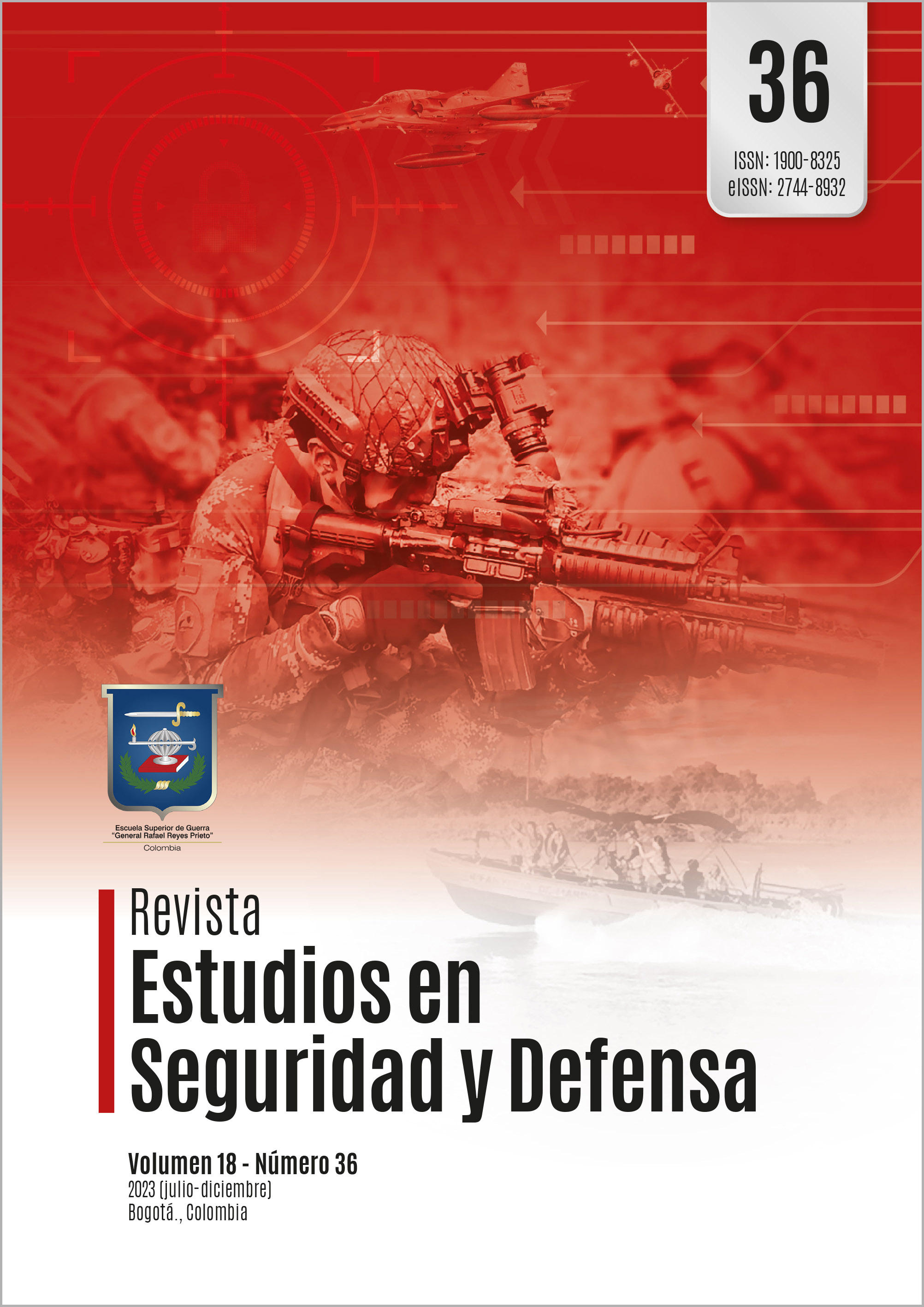Categorizaciones del terrorismo y la violencia de la extrema derecha estadounidense y europea
DOI:
https://doi.org/10.25062/1900-8325.4655Palabras clave:
Estado-nación, extrema derecha, radicalización, seguridad, terrorismo, violenciaResumen
El terrorismo aqueja a la sociedad global por la violencia y daños que provoca en las poblaciones, así como a la estabilidad de los gobiernos. A partir del siglo XXI, grupos e individuos de extrema derecha optaron por la vía violenta y la actividad terrorista como estrategia de operación, de ahí que el objetivo de este artículo fue el análisis del terrorismo en su forma actual, con especial énfasis en su relación con los movimientos de extrema derecha surgidos en los Estados Unidos de América y Europa. Con base en la literatura especializada y de los datos cuantitativos se llegó a la conclusión de que los hechos terroristas han disminuido en general, sin embargo, los incidentes violentos por parte de la extrema derecha radicalizada van en aumento de manera consistente.
Biografía del autor/a
Edgar Ortiz-Arellano, Universidad Nacional Autónoma de México
Doctor en gestión estratégica y políticas del desarrollo; maestro en administración de negocios internacionales licenciado en ciencia política. Es egresado del Curso Combatiendo a las Redes de Amenazas Transnacionales (2021) del Centro de Estudios Hemisféricos de Defensa William J. Perry. Actualmente es catedrático en la Universidad Nacional Autónoma de México.
Referencias bibliográficas
Auger, V. (2020). Right-Wing terror: A fifth global wave? Perspectives on Terrorism, 14(3): 87-97. https://www.universiteitleiden.nl/binaries/content/assets/customsites/perspectives-on-terrorism/2020/issue-3/auger.pdf
Baele, S., Brace, L. y Coan, T. (2021). Variations on a theme? Comparing 4chan, 8kun, and other chans’. Far-Right “/pol” boards. Perspectives on Terrorism, 15(1): 65-80. https://www.universiteitleiden.nl/binaries/content/assets/customsites/perspectives-on-terrorism/2021/issue-1/baele-et-al.pdf
Bury, P. (2022). Post-Fordism and the transformation of transatlantic counter-terrorism. Studies in Conflict & Terrorism: 1-25. DOI: 10.1080/1057610X.2021.2025020
Byman, D. (2021). White supremacy, terrorism, and the failure of reconstruction in the United States. International Security 46(1): 53-103. https://doi.org/10.1162/isec_a_00410
Coccia, M. (2018). The relation between terrorism and high population growth. Journal of Economics and Political Economy, 5(1): 84-104. https://www.academia.edu/65071830/The_Relation_between_Terrorism_and_High_Population_Growth
Collins, J. (2021). A new wave of terrorism? A comparative analysis of the rise of far-right terrorism. Perspectives on Terrorism, 15(6): 2-21. https://www.universiteitleiden.nl/binaries/content/assets/customsites/perspectives-on-terrorism/2021/issue-6/collins.pdf
Couto G., Pimentel, P. Rojas, C. y Castanho R. (2021). The impact of terrorism on capital markets. WSEAS. Transactions on Business and Economics, 18: 962-968. DOI: 10.37394/23207.2021.18.91
Doering S. y Garth, D. (2021). The contextual nature of right-wing terrorism across nations. Terrorism and Political Violence, (33)5: 1071-1093. DOI: 10.1080/09546553.2019.1598390
Dubuisson, F. (2017). La définition du “terrorismo”: débats, enjeux et fonctions dans le discours juridique. Confluences Méditerranée, (102): 29-45. https://doi.org/10.3917/come.102.0029
El Masri, M. y Phillips, B. (2021). Threat perception, policy diffusion, and the logic of terrorist group designation. Studies in Conflict & Terrorism. DOI: 10.1080/1057610X.2021.2011711
ELDoh, M. (2020). Covid-19 and the increasing risk of terrorism. Global Security Review. https://globalsecurityreview.com/covid-19-and-the-increasing-risk-of-terrorism/
Elliot, B. (2022). Examples of trinitarian forces and structures in the terrorist threat: Applications for terrorist warning. Small Wars Journal: 1-8. https://smallwarsjournal.com/jrnl/art/examples-trinitarian-forces-and-structures-terrorist-threat-applications-terrorist-warning
European Union Agency for Law Enforcement Cooperation (2018). European Union Terrorism Situation and Trend Report 2018. The Hague: Europol. https://www.europol.europa.eu/cms/sites/default/files/documents/tesat_2018_1.pdf
Greitens, S., Lee, M. y Yazici E. (2020). Counterterrorism and preventive repression: China's changing strategy in Xinjiang. International Security, 44(3): 9-47. https://doi.org/10.1162/isec_a_00368
Grinyer, J. y Pazos, P. (2020). European Union Terrorism Situation and Trend Report 2020. European Union Agency for Law Enforcement Cooperation. https://www.europol.europa.eu/cms/sites/default/files/documents/european_union_terrorism_situation_and_trend_report_te-sat_2020_0.pdf
Grizold, A. (1994). The concept of National Security in the contemporary world. International Journal on World Peace, XI(3): 37-53. https://www.jstor.org/stable/20751984
Held, V. (2004). Terrorism and war. The Journal of Ethics, (8): 59-75. https://doi.org/10.1023/B:JOET.0000012252.68332.ff
Immordino, G., Karakoç, G. y Piccolo, S. (2018). Terrorism, counterterrorism and optimal striking rules. Revue Économique, 69: 961-984. https://doi.org/10.3917/reco.696.0961
Institute for Economics & Peace. (2020). Global Terrorism Index 2020. Briefing Measuring the Impact of Terrorism. Institute for Economics & Peace. https://www.visionofhumanity.org/wp-content/uploads/2020/11/GTI-2020-Briefing.pdf
Institute for Economics & Peace. (2022). Global Terrorism Index 2022: Measuring the Impact of Terrorism. Institute for Economics & Peace. https://www.economicsandpeace.org/wp-content/uploads/2022/03/GTI-2022-web-09062022.pdf
Jensen, M., Kane, S. y Akers, E. (2022a). Extremism in the Ranks and After. College Park, MD: START. https://www.start.umd.edu/sites/default/files/publications/local_attachments/Extremism%20In%20the%20Ranks%20and%20After%20-%20Research%20Brief%20-%20July%202022%20Final.pdf
Jensen, M., Yates, E. y Kane, S. (2022b). Proud Boys Crimes and Characteristics. College Park, MD: START. https://www.start.umd.edu/sites/default/files/publications/local_attachments/Proud%20Boy%20Crimes%20and%20Characteristics%20January%202022%20FINAL.pdf
Jones, S., Doxsee, C. y Harrington, N. (2020). The Right-Wing Terrorism Threat in Europe. Washington, D.C. Center for Strategic and International Studies. https://www.csis.org/analysis/right-wing-terrorism-threat-europe
Karčić, H. y Beutel, A. (2022). Far-Right nativism: Its geopolitical effects and its future in North America and Europe. Washington, D.C.: New Lines Institute for Strategy and Policy. https://newlinesinstitute.org/wp-content/uploads/20220106-Nativism-Briefingx-NLISAP-1.pdf
Kirisci, M. (2019). Militarized law enforcement forces, state capacity and terrorism. Terrorism and Political Violence, 34(1): 93-112. DOI: 10.1080/09546553.2019.1668376
Klein, G. (2021). Refugees, perceived threat & domestic terrorism. Studies in Conflict & Terrorism: 1-32. DOI: 10.1080/1057610X.2021.1995940
Koch, A. (2022). The ONA network and the transnationalization of Neo-Nazi-Satanism. Studies in Conflict & Terrorism. DOI: 10.1080/1057610X.2021.2024944
Koehler, D. (2019). Violence and Terrorism from the Far-Right: Policy Options to Counter an Elusive Threat. ICCT Policy Brief: 1-21. https://www.jstor.org/stable/resrep19617
Kunst, J., Obaidi, M., Coenen, A., Vasseljen, D. y Gill, P. (2021). What makes a terrorist? Muslims’ and non-muslims’ lay perceptions of risk factors and their consequences for counter-terrorism policy support. Terrorism and Political Violence: 1-24. DOI: 10.1080/09546553.2021.1967149
Latif, M., Blee, K. Matthew DeMichele, M. y Pete Simi, P (2023) Do white supremacist women adopt movement archetypes of mother, whore, and fighter? Studies in Conflict & Terrorism, 46(4): 415-432: https://doi.org/10.1080/1057610X.2020.1759264
MacDonald, K. (2004). Can the Jewish Model Help the West Survive? Discurso de aceptación del The 2004 Jack London Literary Prize. https://web.archive.org/web/20070224212645/http://www.kevinmacdonald.net/WestSurvive.htm
Manwaring, M. (2021). The strategic realities of Twenty-First century “small wars”. Small Wars Journal: 1-7. https://smallwarsjournal.com/jrnl/art/strategic-realities-twenty-first-century-small-wars-opinion-essay
Mearsheimer, J. (2019). Bound to fail: The rise and fall of the liberal international order. International Security, 43(4): 7-50. https://doi.org/10.1162/isec_a_00342
Miller, E. (2018). Global Terrorism in 2017. College Park, MD: START. https://www.start.umd.edu/pubs/START_GTD_Overview2017_July2018.pdf
Miller, E. (2019). Global Terrorism in 2018. College Park, MD: START. https://www.start.umd.edu/sites/default/files/publications/local_attachments/START_GTD_TerrorismIn2018_Oct2018.pdf
Miller, E. (2020). Global Terrorism Overview: Terrorism in 2019. Background Report. College Park, MD: START. https://www.start.umd.edu/pubs/START_GTD_GlobalTerrorismOverview2019_July2020.pdf
Mir, A. (2018). What explains counterterrorism effectiveness? Evidence from the U.S. Drone war in Pakistan. International Security, 43(2): 45-83. https://doi.org/10.1162/isec_a_00331
Mudde, C. (2010) The populist radical right: A pathological normalcy. West European Politics 33(6): 1167-1186. https://doi.org/10.1080/01402382.2010.508901
Parrott, B. (2022). Lessons of the Cold War: Getting it wrong. Journal of Cold War Studies, 24(1): 219-249. https://doi.org/10.1162/jcws_a_01060
Pauwels, A. (2021). Contemporary manifestations of violent right-wing extremism in the EU: An overview of P/CVE practices. Luxembourg: Publications Office of the European Union. https://home-affairs.ec.europa.eu/system/files/2021-04/ran_adhoc_cont_manif_vrwe_eu_overv_pcve_pract_2021_en.pdf
Phelps, M. (2021). The role of the private sector in counter-terrorism: a scoping review of the literature on emergency responses to terrorism. Security Journal, 34(4): 599-620. https://doi.org/10.1057/s41284-020-00250-6
Phillips, B. (2021). How did 9/11 affect terrorism research? Examining articles and authors, 1970–2019. Terrorism and Political Violence: 1-24. DOI: 10.1080/09546553.2021.1935889
Puar, J. (2017). Ensamblajes Terroristas. El homonacionalismo en tiempos queer. Barcelona: Ediciones Bellatierra.
Rapoport, D. (2004). The four waves of modern terrorism. En Cronin A. y Ludes, J. (eds). Attacking Terrorism: Elements of a Grand Strategy. Washington, D.C.: Georgetown Univ. Press, pp. 46-73. https://www.international.ucla.edu/apc/article/47153
Rapoport, D. (2021). The Capitol attack and the 5th terrorism wave. Terrorism and Political Violence, 33(5): 912-916. https://doi.org/10.1080/09546553.2021.1932338
Richards, I. (2019). A philosophical and historical analysis of “Generation Identity”: Fascism, online media, and the European new right. Terrorism and Political Violence, 34(1): 28-47. DOI: 10.1080/09546553.2019.1662403
Skaik H. (2018). Terrorism, orientation and substantial directions Islamic terrorism in the Syrian context. (Master´s Thesis, MA in Ethnic and Migration Linköping University - Department of Social and Welfare Studies). https://www.academia.edu/63407970/Terrorism_Orientation_and_Substantial_Directions
Tillett, J. (2021). Understanding lone-actor terrorists: The global context and how it can be applied to New Zealand. National Security Journal, 3(3): 1-29. DOI: 10.36878/nsj20210829.01
Tillman, D. (2021). Redefining terrorism in the 21st century. Small Wars Journal:1-6. https://smallwarsjournal.com/jrnl/art/redefining-terrorism-21st-century
United Nations. (2020). UNCCT Annual Report 2020. New York: United Nations. https://www.un.org/counterterrorism/sites/www.un.org.counterterrorism/files/uncct_annual_report_2020.pdf
Vasiliauskienė, V. y Vasiliauskas, M. (2020). Definition of terrorism and EU counter-terrorism policy. Border Security and Management, 3(8): 88-99. https://doi.org/10.17770/bsm.v3i8.5362
Velias, A. y Corr, J. (2017). Effects of terrorism threat on economic preferences: The role of personality. Journal of Terrorism Research, 8(2): 62-72. https://doi.org/10.15664/jtr.130
Wieviorka, M., Álvarez-Benavides, A. y Toscano, E. (2021). La sociología del sujeto y el estudio de las nuevas extremas derechas. Encrucijadas: Revista Crítica de Ciencias Sociales, 21(2): 1-17. https://recyt.fecyt.es/index.php/encrucijadas/article/view/92658
Cómo citar
Descargas
Publicado
Número
Sección
Licencia
Derechos de autor 2023 Estudios en Seguridad y Defensa

Esta obra está bajo una licencia internacional Creative Commons Atribución-NoComercial-SinDerivadas 4.0.

| Estadísticas de artículo | |
|---|---|
| Vistas de resúmenes | |
| Vistas de PDF | |
| Descargas de PDF | |
| Vistas de HTML | |
| Otras vistas | |
















